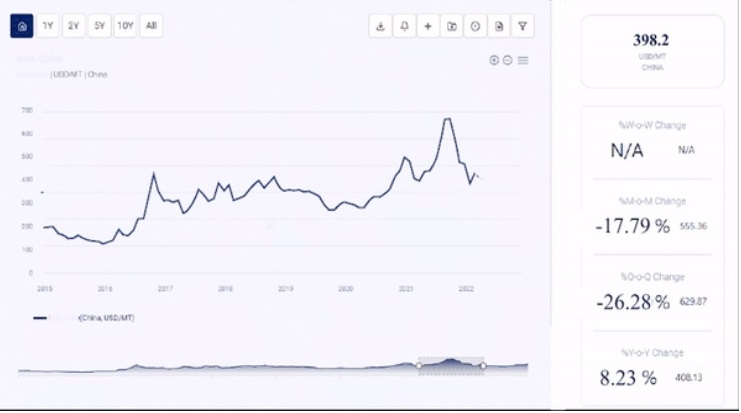Lincomycin Hydrochloride, a derivative of lincomycin, is a crucial antibiotic used in both human and veterinary medicine. Known for its effectiveness against a variety of bacterial infections, this compound plays a significant role in healthcare. Understanding its price trends is essential for stakeholders ranging from healthcare providers to pharmaceutical companies. This report delves into the price trends of lincomycin hydrochloride, providing insights into its market dynamics, future forecasts, and the latest developments impacting its cost.
Forecast Report
Predicting the price trends of Lincomycin Hydrochloride involves analyzing various factors, including raw material costs, manufacturing expenses, regulatory changes, and market demand. According to market analysts, the global lincomycin hydrochloride market is expected to witness moderate growth over the next five years. This growth is driven by the increasing prevalence of bacterial infections, advancements in antibiotic formulations, and the rising demand for effective veterinary antibiotics.
Request For Sample: https://www.procurementresource.com/resource-center/lincomycin-hydrochloride-price-trends/pricerequest
The forecast indicates a steady increase in demand for Lincomycin Hydrochloride, especially in developing regions where bacterial infections remain a significant health challenge. However, the market is also likely to face challenges such as stringent regulatory frameworks and the emergence of antibiotic resistance, which could impact the overall market dynamics.
Market Analysis
- Supply Chain Dynamics: The supply chain for Lincomycin Hydrochloride involves several stages, including raw material procurement, manufacturing, distribution, and final sale. Fluctuations in the prices of raw materials, such as lincomycin, directly affect the overall cost of Lincomycin Hydrochloride. Additionally, disruptions in the supply chain, caused by geopolitical tensions or natural disasters, can lead to price volatility.
- Demand and Consumption Patterns: The demand for Lincomycin Hydrochloride is influenced by its application in treating infections in humans and animals. The human healthcare sector remains the largest consumer, followed by the veterinary sector. Increased awareness about antibiotic treatments and growing incidences of bacterial infections are driving demand. However, the emergence of antibiotic-resistant strains of bacteria poses a significant threat, potentially leading to reduced efficacy and lower demand.
- Regulatory Environment: Regulatory bodies across the globe have stringent guidelines for the production and sale of antibiotics, including Lincomycin Hydrochloride. Compliance with these regulations ensures the safety and efficacy of the drug but also adds to the production costs. Changes in regulatory policies, such as the introduction of new safety standards or restrictions on antibiotic use in animals, can significantly impact the market.
- Competitive Landscape: The Lincomycin Hydrochloride market is highly competitive, with several key players vying for market share. Major pharmaceutical companies invest heavily in research and development to improve the formulation and efficacy of their products. Additionally, mergers and acquisitions are common strategies to strengthen market position and expand product portfolios.
Latest News
- Technological Advancements: Recent advancements in biotechnology and pharmaceutical manufacturing processes are enhancing the production efficiency of Lincomycin Hydrochloride. Innovations such as bio-fermentation and green chemistry are reducing production costs and environmental impact, contributing to more stable prices.
- Market Expansion: Pharmaceutical companies are expanding their presence in emerging markets, where the demand for antibiotics is growing. Strategic partnerships and collaborations are helping companies to penetrate these markets and cater to the rising demand for Lincomycin Hydrochloride.
- Regulatory Changes: The regulatory landscape is continually evolving, with new policies aimed at curbing antibiotic resistance. For instance, the European Union has introduced regulations to restrict the use of certain antibiotics in veterinary medicine, which could influence the demand and pricing of Lincomycin Hydrochloride in the region.
- COVID-19 Impact: The COVID-19 pandemic has had a mixed impact on the Lincomycin Hydrochloride market. While the initial outbreak led to disruptions in the supply chain and increased production costs, the heightened focus on healthcare has driven demand for antibiotics. The pandemic has also underscored the importance of robust supply chains and the need for strategic stockpiling of essential medications.
Conclusion
The Lincomycin Hydrochloride market is characterized by dynamic factors that influence its pricing trends. From supply chain disruptions and regulatory changes to advancements in manufacturing processes and shifts in demand patterns, various elements play a crucial role in determining the cost of this antibiotic. As the market continues to evolve, stakeholders must stay informed about these trends to make strategic decisions. The forecast indicates moderate growth, driven by increasing demand and technological advancements, although challenges such as antibiotic resistance and regulatory hurdles persist. By understanding these factors, stakeholders can navigate the complexities of the Lincomycin Hydrochloride market and leverage opportunities for growth and innovation.
In conclusion, staying abreast of the latest developments, market analyses, and forecast trends is essential for anyone involved in the Lincomycin Hydrochloride market. This report provides a comprehensive overview, equipping stakeholders with the insights needed to understand and anticipate changes in this critical segment of the pharmaceutical industry.

No Responses